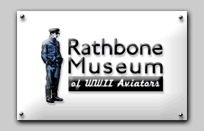 |
|
|
 |
 |
 |
 |
|
 |
 |
 |
|
|
|
 |
|
|
|
Two-piece summer weight flight suit (all items courtesy of Gene Ashton, Collector) |
|
|
 |
|
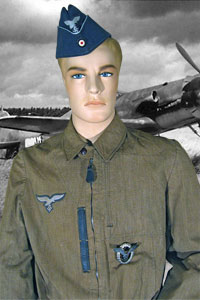 |
|
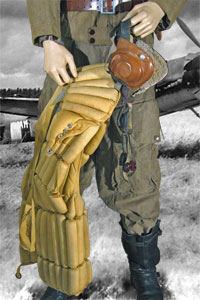 |
|
|
| This Luftwaffe officer fighter pilot is wearing the lighter weight two-piece summer flight suit in what is call the "mediterranean pattern" fabric. The fabric is the typical brown-grey salt and pepper style used for the on piece combination suit. |
|
The two piece suite was more than a comfortable flying outfit. It was designed to carry all necessary items for flight and survival including map pockets, emergency rations, first aid kits, drinking water cans and dye kits for water ditching. The leather strip on the front of the jacket is a for clipping the oxygen mask to the jacket. |
|
The bottom pants feature large pockets on top of the thigh that are more easily available when sitting in a cramped cockpit. They are worn with zip up flying boots with hard leather bottoms and soft shearling uppers. |
|
|
|
|
|
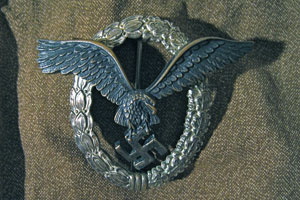 |
|
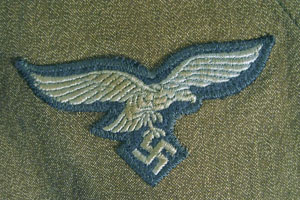 |
|
|
| As the suit was the primary uniform worn in flight, Luftwaffe insignia was worn directly on the front. This is the standard Luftwaffe pilot badge fastened with a large vertical pin throught the fabric. Typically a blue officer's shirt would be worn underneath the jacket with rank worn on the shoulders. |
The unique swept-wing Luftwaffe eagle was worn on all Luftwaffe uniform and equipment as a branch of service device. This eagle has been machine-sewn directly to the jacket front. |
|
|
|
|
|
|
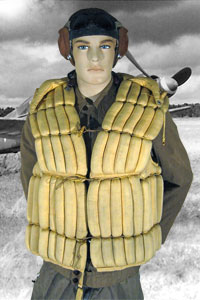 |
|
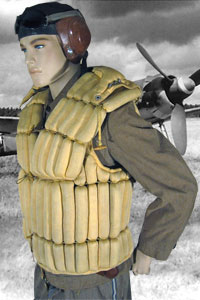 |
|
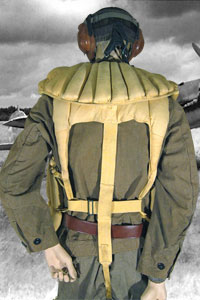 |
|
|
| Preparing for flight, the pilot dons his LKpN-101 flight helmet with a net top. This helmet could have been worn with the two strap or three strap model oxygen mask. Strapped at the top of the helmet are the hinged, hard plastic Splitterschutzbrille goggles. These goggles were designed as a replacement to typical glass lenses to prevent collateral damage to the pilot in a crash. |
Over the jacket, the pilot wears a cotton fabric Schwimmweste model 10-76B-1 filled with kapok, a specially buoyant fibre from the seedpods of the Kapok tree. These jackets were simple and often superior over early designs of the inflatable type life vests that tended to leak. |
|
What makes the model 10-76B-1 unique and an improvement over its predecessor is the lack of kapok in the back. This made the vest float more forward, keeping the pilot's head up out of the water. This vest was introduced in 1943. |
|
|
|
|
|
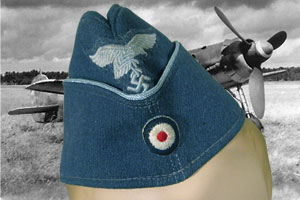 |
|
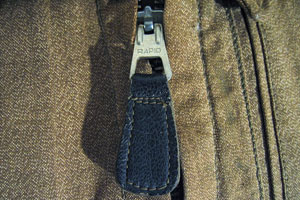 |
|
|
|
When not flying, this pilot wears the officer's model of the Luftwaffe side cap, as signified by the silver piping. |
A close-up of the metal zipper on the fron of the jacket marked "Rapid", a popular German brand. By the end of the war almost all these zippers were made of plastic. |
|
|
|
|
|
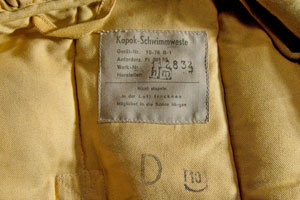 |
|
|
| The manufacturer's tag on the 10-76B-1 Schwimmweste. |
|
|
|
|
|
|
|
| © Tod Rathbone |
|
|
|
|
|
|
|
|
|
|
|
|
|
|
|
|
|
|
|
|
|
|
|
|
|
|
|
|
|
|



















